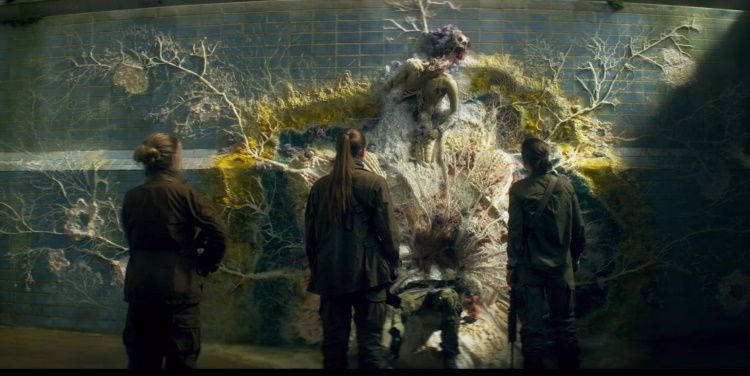The book is often categorized as weird fiction and, while I am
less than certain what criteria are used to define that genre, Annihilation
is very weird indeed. It tells a story of four women who are never named and
only known by their occupations: a biologist, a psychologist, an anthropologist,
and a surveyor. They go on a mission into Area X, an area free of human
inhabitants and blocked off from the general public. (Very much like
Tarkovsky's Stalker.) Other expeditions have preceded this one – it's
the 12th – and they have all ended disastrously. What happens in
Area X stays in Area X. Those who return suffer from amnesia and virulent cancers
that cut their lives short.
And, honestly, the tower scared the crap out of me. Inside a
structure is a tunnel with a spiral staircase ominously leading down which the
biologist calls the tower. On the walls writing consisting of a plant-like material
spells out a lengthy phrase that makes me imagine what T.S. Eliot's "The
Waste Land" would be like if he had co-written it with Lovecraft. It
begins:
"Where lies the strangling fruit that came from the
hand of the sinner I shall bring forth the seeds of the dead to share with the
worms that gather in the darkness and surround the world with the power of
their lives while from the dimlit halls of other places…"
And, down in the dark depths of the tower was the Crawler.
Let us not go there.
For his film, writer/director Alex Garland took VanderMeer's
novel as the basis of a story and went off in his own direction. Despite the
changes he wrought, Annihilation the movie kept me uneasy almost the whole
time and I descended into terror on the odd occasion as well.
There is much more clarity here as we find out at the
beginning that a something from outer space crashes on Earth, more
specifically, into a lighthouse. Four intrepid adventurers becomes five with
the addition of a medic. And they are given names: Dr. Ventress (psychologist),
Lena (biologist), Radek (physicist), Sheppard (geomorphologist), and Thorensen,
the medic.
Here in the film, Lena's relationship with her husband is
more fleshed out and the central motivation for her entering the Shimmer, Area
X in the book. Instead Ventress, a cold, stoic face to a nameless bureaucracy
is perhaps more like the novel's biologist.
Whereas VanderMeer focused on the fellowship's descent into
madness and dissolution, Garland emphasizes body horror. The Shimmer is where
DNA gets shoehorned where it not only just shouldn't be but where it cannot be. It's
almost a Dantean journey but instead of going deeper into hell and meeting
souls who committed ever more heinous crimes, we see relatively minor feats of
genetic splicing and dicing become more severe until finally our protagonists
destruct.
The first step is a single vine sprouting a variety of
disparate flowers and this is followed by an alligator with shark-like teeth.
The gator, which briefly threatens our adventurers, is almost a cheap horror movie
trope. As Lena says during her debriefing/interrogation after emerging from the
Shimmer, the mutations got more strange and severe the closer they got to the
lighthouse and that's when things get really creepy.
Even more disturbing for me was the section of the film at
the Army base. They come across an abandoned Army base and discover that a
previous expedition had bivouacked there. A memory card from a camcorder was
left to be found and on it is footage of Lena's husband cutting open the gut of
a fellow solder to reveal a worm-like parasite writing in his abdominal cavity.
They find the setting of this video – in a pool – and see that the poor guy's
body had been ripped apart and stuck to a side of the pool via the rainbow moss
that is seemingly everywhere in the Shimmer.
The left forearm is the site of, not only the tattoo, but
also a bruise on Lena. Plus it is where we notice plants growing out of the physicist's
body. It's the place on the body where markers reside, markers indicating
something is wrong. Ultimately, though, it's just a leitmotif with little inherent
meaning. I suppose the tattoos themselves are much the same. There's no
discernible pattern to their appearance but viewers come to understand that
their presence means something is amiss. Its purpose is to induce a certain sense
of unease rather than give a definitive explanation of how the Shimmer works.
Almost none of us commit suicide, and almost all of us
self-destruct. In some way, in some part of our lives. We drink, or we smoke,
we destabilize the good job... and a happy marriage. But these aren't
decisions, they're... they're impulses.
After Lena cops to not understanding, the psychologist
answers:
Isn't the self-destruction coded into us? Programmed into
each cell?
There are many examples of self-destruction in the film. The
physicist cuts herself while the medic is an addict. We learn that the psychologist
has cancer – her body is literally killing itself. And Lena has an affair
which jeopardizes her marriage. Plus there's that tattoo which is the Ouroboros
snake in the shape of the infinity symbol perhaps saying that self-destruction
is a never-ending process.
But these are all from our viewpoint. The being behind the Shimmer
seems to think otherwise.
During her debriefing, Lena's interlocutor describes the genetic
mutations happening within the Shimmer as "nightmarish" but Lena
retorts, "Not always. Sometimes it was beautiful." Later she says of
it, "It wasn’t destroying. It was changing everything. It was making
something new." I am reminded of something F. Scott Fitzgerald wrote in
"The Crack-Up":
A man does not recover from such jolts—he becomes a
different person, and, eventually, the new person finds new things to care
about.
The movie seems to argue that, at least sometimes, self-destruction
is really out with the old and in with the new.
None of this is to say that I think the film is a visual
disquisition on the theme of self-destruction. It's more of a meditation.
So that's why I love Annihilation. It's sublime in a
more Burkean sense for me, that is, since so much is unexplained or obscure, it
evokes potent and terrific feelings of confusion as well as the uncanny and I
use "terrific" here in its old meaning of causing terror. There's
trauma here but it transcends the mundane. It makes the horrible beautiful in
its own way.





No comments:
Post a Comment